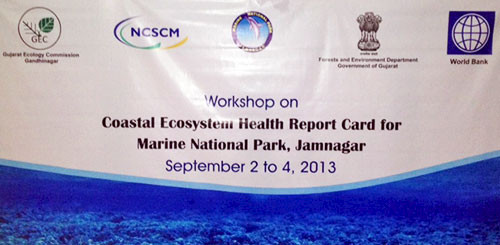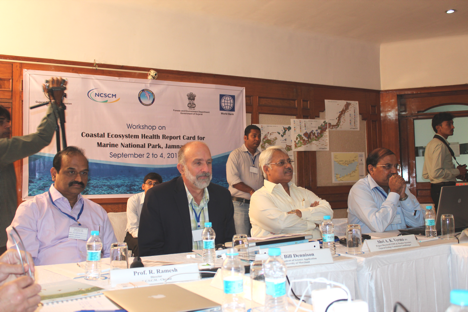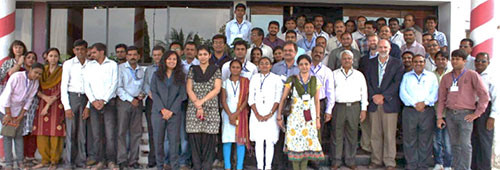Gulf of Kachchh report card workshop
Bill Dennison ·An IAN contingent traveled to Jamnagar, India to conduct a two day workshop to develop an environmental report card for the Gulf of Kachchh (rhymes with touch). Bill Dennison, Heath Kelsey and Jane Hawkey made the trip, and although Simon Costanzo was scheduled to come, his Indian visa didn't arrive in time. Just as the IAN team had done earlier this year in developing a report card for Chilika Lake on the East coast, we partnered with a team from the National Centre for Sustainable Coastal Management, based in Chennai. We met them in Mumbai (Bombay) and flew to Jamnagar together.

By way of background, the Integrated Coastal Zone Management (ICZM) project in India is being implemented by the Ministry of Environment and Forests, Government of India, in collaboration with the World Bank. In the first phase of the ICZM project, three coastal states in India (Gujarat, Odisha, and West Bengal), all with long coastlines and unique biodiversity conditions, have been identified as the areas for pilot implementation. Each state has a State Project Management Unit (SPMU), which, for the State of Gujarat, the Gujarat Ecology Commission (GEC) has been designated. Under the excellent guidance and support of GEC Member Secretary and Project Director, Dr. A.K. Verma IFS, along with the Gujarat Ecological Education and Research Foundation (GEER), and a team of supporting government agencies, this report card workshop was organized in Jamnagar. The Chief Conservator of Forests, Mr. R.D. Kamboj, IFS, of the Marine National Park-Jamnagar, assisted with the workshop facilitation.

A second workshop, two days later in Gandhinagar, was also organized by the GEC, GEER, and many supporting government agencies, to create an environmental impact assessment framework for the entire Gulf of Kachchh. Mr. H.K. Dash, IAS, Additional Chief Secretary, Government of Gujarat, inaugurated this workshop and Dr. A.B. Harpanahalli, National Project Director, SICOM, MoEF (ICZM Projects) participated.

The Gulf of Kachchh is in the state of Gujarat in the northwest corner of India, bordering with Pakistan. It is one of two gulfs in Gujarat - the other is the Gulf of Khambhat. Both gulfs have large tidal ranges, exchanging water with the Arabian Sea. The Gulf of Kachchh has coral reefs and extensive mangroves and hosts large populations of resident and migratory birds. The region also supports a large industrial base, including one of the world's largest oil refineries. There is a National Marine Park and Sanctuary along the south coast of the Gulf of Karchchh and the report card was focused on this protected area.
The report card workshop began with some introductory remarks by the local environmental leaders. A multi-wicked candle was lit by six people, signifying the coming together of different groups. Then everyone was ceremoniously handed a very nice bouquet of flowers. The workshop was held in a hotel where we also slept and ate our meals. There were nearly 70 people who participated in the workshop, and sometimes it felt as if all 70 people were talking at once. We learned that this seemingly chaotic style of interacting was actually able to deliver good outcomes. It also took us a while to figure out the local schedule. The Gujarat people start their workday at 10 or 10:30am, have lunch at 2 pm and work until 6 pm. Dinner is typically not until 8 pm.

We established the reporting zones (the islands and the western, central, eastern coastal gulf), the ecosystem health indicators (water quality, biodiversity and fisheries) and the various thresholds for indicators. The Gulf of Kachchh has both some amazing ecosystems and some major threats. Historically, mangrove cutting (for wood and fuel as well as providing space for salt pans) and coral mining (for cement) took place in the Gulf, but these practices were banned when the Marine National Park was created in 1982. A major mangrove restoration program was initiated to rebuild the mangrove forests, which is showing some good progress. A coral transplant program and a sea turtle hatching program have also been initiated.

More recent environmental threats to the Gulf of Kachchh include the increased shipping and port development, a large evaporative salt industry on the intertidal flats, agricultural and sewage runoff, and suspended and deposited sediments. The large tide range (3-7 m) and deep central basin means that dilution is a major factor in dissipating the impact of human activities on the Gulf. One of the industries that is just now being phased out is that of 'shipbreaking'. This is where they take various large decommissioned ships and run them aground at high tide, taking advantage of the large tidal range. Then the ships are taken apart piece by piece for scrap metal. Shipbreaking will continue in the Gulf of Khambhat with its greater tide range and relative lack of coral reefs.
As part of the workshop, we asked participants to list the grades that they thought were appropriate for each of the reporting regions. The results were amazingly consistent, with islands receiving the best grades, followed by the western, central and eastern regions. When we calculate the quantitative grades, we will cross-reference them with these expert opinion rankings.

We only had two days for conducting this workshop which initially worried us. Fortunately, we had the recently published the Chilika Lake example, which helped us communicate our approach to the group. We had a wide variety of sectors represented at the workshop which helped us develop a broad ranging consensus. We were very happy with the progress we were able to make in such a short time frame and look forward to finishing by the end of the calendar year.
About the author
Bill Dennison

Dr. Bill Dennison is a Professor of Marine Science and Vice President for Science Application at the University of Maryland Center for Environmental Science.

